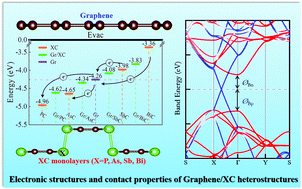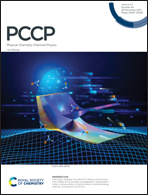First-principles study on the electronic structures and contact properties of graphene/XC (X = P, As, Sb, and Bi) van der Waals heterostructures†
Abstract
The electrical contacts at the van der Waals (vdW) interface between two-dimensional (2D) semiconductors and metal electrodes could dramatically affect the device performance. Herein, we construct a series of graphene (Gr)/XC (X = P, As, Sb, and Bi) vdW heterostructures, in which XC monolayers have aroused considerable attention recently as an emerging class of 2D semiconductors. The electronic structures and contact properties of Gr/XC vdW heterostructures are investigated systematically using first-principles calculations. The band structures indicate that both Gr/PC and Gr/AsC heterostructures form n-type Schottky contacts with Schottky barrier heights (SBHs) of 0.01 eV and 0.43 eV, respectively, while both Gr/SbC and Gr/BiC heterostructures preferably form Ohmic contacts. The different X atoms result in different work functions, electron flows, charge distributions and orientations of the dipole moment in Gr/XC heterostructures. Moreover, the tunneling probabilities increase with the increasing atom radius of X from P to Bi, indicating the most improved current and smaller contact resistance at the interfaces of Gr/BiC compared to Gr/PC, Gr/AsC and Gr/SbC heterostructures. Our work could provide meaningful information for designing high-performance nanoelectronic devices based on Gr/XC heterostructures.



 Please wait while we load your content...
Please wait while we load your content...